Admissions open for YEAR 2026-27
Montessori at Home: How It Naturally Builds Independence in Children
Independence begins at home—and the Montessori approach makes it beautifully natural. In this post, we explore simple, everyday ways Indian parents can nurture independence in their children using Montessori principles. From child-sized spaces and real-life tasks to trusting your child’s capabilities, this guide will help you raise confident, capable, and self-reliant little ones in your own home.
PARENT RESOURCES
Little Florets' Montessori
3/22/20256 min read


In Montessori education, independence is not just a skill—it’s a way of life. From the moment a child enters a Montessori classroom, they are gently guided to do things for themselves, at their own pace, in their own time. But independence doesn’t begin and end at school. In fact, the home is the first place where a child’s confidence and self-belief are nurtured.
In Indian households—often bustling, multigenerational, and lovingly hands-on—it can be tempting to do everything for our children. We want to protect them, help them, and make life easier for them. But when we allow children to do things by themselves, we’re actually giving them something even more valuable: a sense of capability.
Here are some beautifully simple, Montessori-inspired ways to nurture independence at home.
Montessori at Home: How It Naturally Builds Independence in Children




Slowing Down to Let Them Try
It’s quicker to button their shirt for them or tie their shoelaces, especially when you’re rushing out the door. But when we constantly step in, we rob children of the chance to try, fail, and grow.
Montessori invites us to slow down and create space for children to practice—even if it means a little mess or delay.
Let your child:
Pour their own milk from a small steel jug.
Put on their sandals, even if it takes time.
Attempt to sweep a spill with a small broom.
Yes, there may be water on the floor or crooked collars, but the pride in their eyes will tell you it’s worth it.


Encouraging Self-Care Skills
From wiping their face to choosing their outfit, self-care is a vital part of Montessori independence. And children are eager to learn these things—they just need the right environment and our patience.
Create a little “getting ready” station:
A mirror placed at your child’s height
A basket with a comb, handkerchief, and hair oil
Low shelves with neatly folded clothes to choose from
Encouraging your child to care for themselves develops pride, responsibility, and self-awareness.
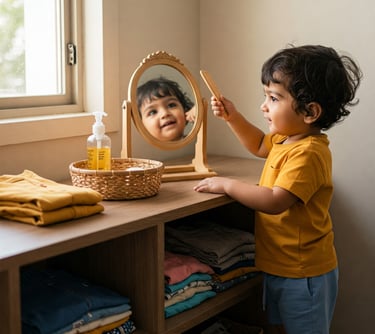

Modelling Instead of Rescuing
In Montessori, adults are guides—not fixers. When a child is struggling, we resist the urge to jump in. Instead, we model slowly and let them try again.
If your child is trying to open a lunchbox or button a shirt, watch patiently. If needed, show them how, step by step, and let them take over. This helps children develop resilience, problem-solving skills, and patience.
Let them know: “It’s okay to try. It’s okay to make mistakes. I’m here if you need help.”
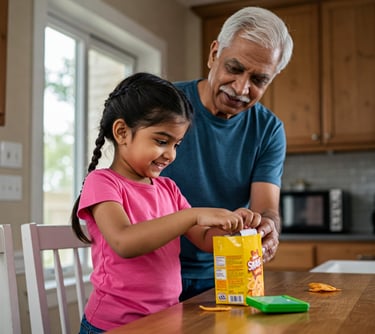

Trusting Your Child’s Capabilities
This is the heart of Montessori—deep trust in the child.
In Indian culture, we often express love by doing things for our children. But Montessori reminds us that love can also be shown by believing in their ability to do things for themselves.
Let your child:
Serve their own food
Pack their school bag
Water a plant every morning
When we step back, they step up. And when we trust them, they begin to trust themselves
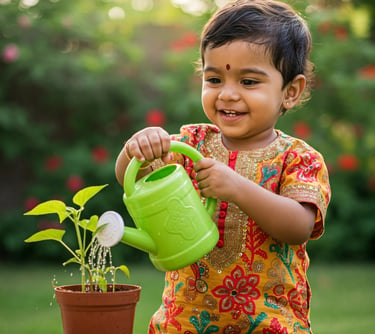

Involving Children in Real, Everyday Tasks
Children don’t need pretend chores—they want to do what the adults around them are doing. Montessori encourages giving children real tasks with real purpose, even from a young age.
In Indian households, there’s no shortage of meaningful work:
Let your child wash vegetables in a small bowl while you prepare dinner.
Ask them to fill up water bottles, carry steel tiffins, or serve rotis to the table.
Allow them to help fold clothes or dust low shelves.
These tasks aren't just about being helpful. They give the child a sense of belonging and show that their contributions matter. Plus, practical life activities build fine motor skills, focus, and order—all foundational Montessori goals.
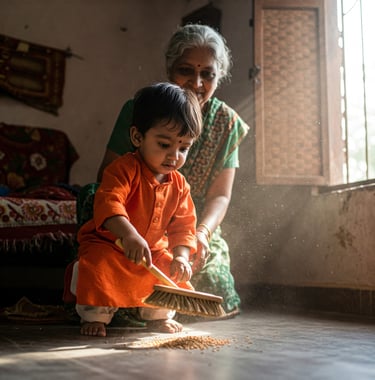

Offering Limited, Thoughtful Choices
Choice gives children a sense of control, but too many options can overwhelm them. Montessori recommends offering limited, clear choices that still give the child agency.
Instead of asking, “What do you want to wear today?” try:
“Would you like your blue kurta or the yellow one?”
“Do you want to eat dosa or poha this morning?”
This approach empowers your child while avoiding decision fatigue. It also helps reduce power struggles, especially during busy mornings.
Keeping Toys and Materials Organized
Montessori promotes “less is more” when it comes to toys and materials. Instead of filling the room with noisy, plastic toys, focus on fewer, purposeful items that are stored neatly and accessibly.
Use open shelves or trays to display toys or books. Rotate them every few weeks to keep interest fresh. And most importantly, involve your child in putting things away.
Even a young toddler can learn: “Take it out, play with it, put it back.” This practice encourages order and respect for belongings.
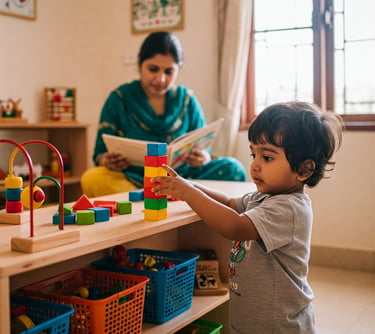

Establishing Simple, Predictable Routines
Montessori emphasizes rhythm over rigidity. A consistent daily routine helps children feel secure and know what’s expected—without constant reminders.
You might create a simple morning and evening flow:
Wake up, brush teeth, get dressed
Breakfast, play, help with housework
Storytime, wind down, bedtime
Even using a basic visual chart with photos or drawings can help young children follow the routine independently. It’s not about strict timetables—it’s about consistency and rhythm.


Using the Right Tools for Little Hands
Montessori environments are filled with child-sized tools designed to fit small hands. At home, you can mirror this by choosing tools that are easy for your child to handle on their own.
In the Indian context, this might include:
A small stainless steel jug for pouring water
A tiny chakla belan (rolling board and pin) to try rolling dough
A low stool to reach the handwashing area
A child-sized broom and dustpan (many local markets have them!)
When the tools fit the child, the child rises to the task.


Final Thoughts
Montessori is not about perfection—it’s about presence. You don’t need to buy expensive materials or change your entire home. Just a few small shifts, grounded in respect and trust, can help your child become confident, responsible, and joyfully independent.
In every Indian home—whether big or small, urban or rural—there are beautiful, everyday opportunities for your child to grow with independence. All it takes is a little patience, some creativity, and a whole lot of faith in your child’s amazing potential.
Creating Child-Sized Spaces
Montessori philosophy teaches us that the environment shapes the child. In many Indian homes, the kitchen counters are high, cupboards are locked, and the bathroom sink is just out of reach. Small changes can make a big difference.
Set up spaces that are just right for your child. This could mean:
Keeping their water bottle, bowl, and spoon on a low shelf in the kitchen.
Adding a small step stool near the wash basin so they can wash their hands and brush their teeth.
Hanging a low hook by the entrance for their bag or jacket.
When children can reach things on their own, they begin to act on their own. These quiet acts of independence build confidence, one step at a time.



